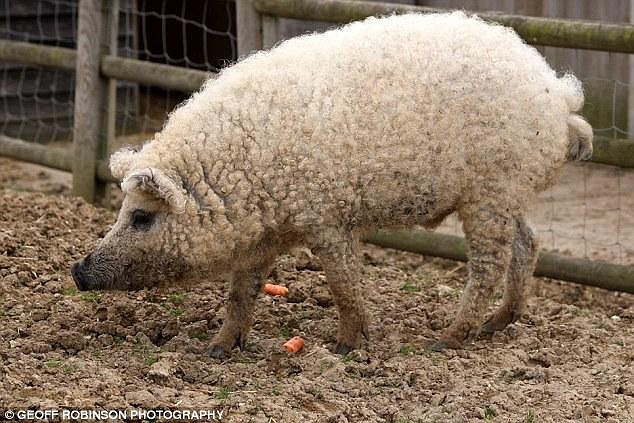Beyond Tiki, Bilge, and Test / Bilge
What is a sheep pig?
Pages: 1 10 replies
|
B
beadtiki
Posted
posted
on
Mon, Apr 26, 2010 7:42 PM
The Hungarian Wooly Pig or Manganitza. How cute?! |
|
W
woofmutt
Posted
posted
on
Mon, Apr 26, 2010 10:53 PM
Apparently "How delicious!" is a more popular comment: **New York Times March 26, 2009 An Old Breed of Hungarian Pig Is Back in Favor By MICHAEL S. SANDERS** LIKE style on the runway, style for pigs is changeable. With their abundant fat, the curly-haired Mangalitsa pigs of Hungary were all the rage a century ago. But as time went on, they became has-beens. Now that succulent pork is back in fashion, the Mangalitsa — saved from near extinction on a farm here at the edge of Hungary’s bleak and barren Great Plain — are making a comeback. Most of those raised here become ham and other cured meats in Spain. But Mangalitsas are also being raised at farms in the United States for chefs who pay as much as 40 percent more for them than for Berkshires, another elite breed. Last Wednesday April Bloomfield at the Spotted Pig in Greenwich Village served the belly and trotters of a Mangalitsa/Berkshire crossbreed with Agen prunes for $32. (She hopes to have more in two to three weeks.) “When I tasted this pig,” Ms. Bloomfield said of the Mangalitsa, “it took me back to my grandmother’s kitchen on a Sunday afternoon, windows steaming from the roasting pork in the oven. Back then pork tasted as it should: like a pig. This pork has that same authentic taste.” Devin Knell, executive sous-chef at the French Laundry, confits the belly of the Mangalitsa (pronounced MAHN-ga-leet-za); roasts the liver, kidneys, and chops, and poaches the saddle sous vide with a garlic mousse. “Unlike workaday pork,” Mr. Knell said, “Mangalitsa is marbled, and the fat dissolves on your tongue — it’s softer and creamier, akin to Wagyu beef.” George Faison, an owner of the New York City specialty meats company DeBragga and Spitler, will start selling chefs pork from Mangalitsas fattened on the West Coast this summer. He said the fat was luscious, more like that of duck than pork. Recalling a tasting for chefs last fall, he said, “The belly meat was unctuous, but it was the loin meat that really impressed me.” Mosefund Farm in Branchville, N.J., sells Mangalitsa pork to restaurants, including the Spotted Pig, for $10 to $11 a pound, about $3 a pound more than what Berkshire pork costs. Ms. Bloomfield said Mosefund sells the Berkshire crossbreed for $7.99 pound. Mangalitsas were bred for their lard on the Hungarian farms of Archduke Joseph in the 1830s. Herds shrank with the collapse of the Austro-Hungarian Empire after World War I and declined further with the introduction of fast-growing white pigs and cheaper, higher quality vegetable oils after World War II. But Peter Toth, a Hungarian animal geneticist, did not want this Hapsburg legacy to be lost. He has worked to save the pigs here on a farm with buildings of whitewashed stone, with roofs of thick thatch. Dimly lighted wooden pens filled with straw shelter piglets and nursing sows. Breeding boars and sows live in pens open at one end. On a tour of the farm, 100 miles east of Budapest, a bitter wind blew out of the Carpathian foothills just visible to the east. Their feed is a mix of barley, wheat, wheat bran, alfalfa, and sunflower seeds, but unlike the feed on factory farms, little corn and nothing with soy. “When Communism collapsed,” Mr. Toth said, “the state farms that served as the last gene banks also collapsed. It was a total anarchy in the country. When I started to save Mangalitsas, to search for them in 1991, I found only 198 purebred pigs in the country. Sometimes, I would rescue the pigs right from the slaughterhouse.” Today his company, Olmos and Toth, in addition to maintaining breeding stock, fattens some 8,000 pigs and oversees the production of 12,000 more on farms in the surrounding regions. Because these pigs can cost 40 percent more to raise, Hungarians, who earn less than most Europeans, use them mostly to make lard and sausages. “The Mangalitsa — many problems!” Mr. Toth said. “We must kill them at 140 kilos” — about 300 pounds — “to make sure that the marbling is maximized and the meat the best quality. If you kill it at 80 kilos” — 176 pounds, when industrially produced pigs are slaughtered — “you won’t have marbled meat. You need time, more than one year, when a normal pig takes five months to raise.” “The second big problem,” he said, “is at the slaughterhouse: the carcass has only half of the quantity of meat and double the fat. So the Mangalitsa product we will have to sell, cured dried ham or fresh loin, always at two to three times more in price.” Also, Mangalitsas give birth to only 5 to 8 piglets instead of the 12 to 14 of more commonly raised breeds. Mr. Toth’s partner, Juan Vicente Olmos Llorente, who runs Monte Nevado in Spain, takes every Mangalitsa ham, loin and shoulder produced on the farms. In Spain, the hams are finished and sold as jamón Mangalica, the most expensive going for $70 a pound, rivaling pata negra hams. Monte Nevado hopes to begin Internet sales in the United States in June at latienda.com. There is one American breeder of Mangalitsas, on the West Coast: Heath Putnam. His company, Wooly Pigs, based in Auburn, Wash., fattens the swine for sale but also sells neutered piglets for others to raise. Mr. Putnam started three years ago with 25 pigs he brought from Europe, before imports were restricted. He now produces about 1,200 piglets a year and has begun selling pork to chefs, wholesaling larger cuts for between $12 and $15 a pound. Mr. Putnam had Christoph Wiesner, an Austrian breeder who selected the Putnam herd, give chefs a workshop on European butchering and curing. “When I opened the belly of the first pig,” Mr. Wiesner said, “you could see the chefs’ eyes getting big. ‘Oh, wow!’ they were saying. ‘Look at that fat!’ You could see they were already thinking what I can do with this part and that.” The workshop took place on the farm of Keith Luce, the executive chef at the Herbfarm Restaurant outside Seattle. “Because it’s so great for curing,” Mr. Luce said, “we’re laying it down and curing the legs predominantly, making lardo, all the traditional things. It’s a true nose-to-tail experience with the Mangalitsa, and there’s not any part we’re not using.” The restaurant has also featured the meat on its tasting menu in a different form almost every night recently. “We were laughing when we tasted it,” Mr. Luce continued. “We couldn’t control ourselves. The taste, the texture was so unbelievable.” Mangalitsas may be too expensive for most local bistros, but Mr. Faison, the specialty meat wholesaler, said there should be a place for them. “We tell the chefs, you got to keep some magic on the menu, some fun,” he said, “because the people are coming in to escape whatever hell they’re facing out there.” |
|
M
MadDogMike
Posted
posted
on
Tue, Apr 27, 2010 6:23 AM
Very interesting info Bead & Woofie |
|
TK
talo ka
Posted
posted
on
Tue, Apr 27, 2010 6:29 AM
holy shyt.!!!!!! |
|
LLT
little lost tiki
Posted
posted
on
Tue, Apr 27, 2010 7:57 AM
Thanks Monsanto! |
|
TG
The Gnomon
Posted
posted
on
Tue, Apr 27, 2010 8:08 AM
So is its meat candy called bah-con? |
|
B
beadtiki
Posted
posted
on
Tue, Apr 27, 2010 9:08 AM
GROOOOOOAAAAANNNN! Very good! |
|
B
beadtiki
Posted
posted
on
Tue, Apr 27, 2010 9:10 AM
Woof - I doubt I could afford to even try this little guy's wares. I just thought he was kinda silly and cute. I bet cleaning the "wool" is no easy chore though! |
|
S
seagoat
Posted
posted
on
Tue, Apr 27, 2010 9:35 AM
What about this thing?
|
|
UB
Unga Bunga
Posted
posted
on
Tue, Apr 27, 2010 1:00 PM
Oh! :D |
|
B
beadtiki
Posted
posted
on
Wed, Apr 28, 2010 11:39 AM
Seagoat - now THAT would be terrifying! Predatory Pig! Old Farmer John would think twice about raising one of these guys! |
Pages: 1 10 replies


